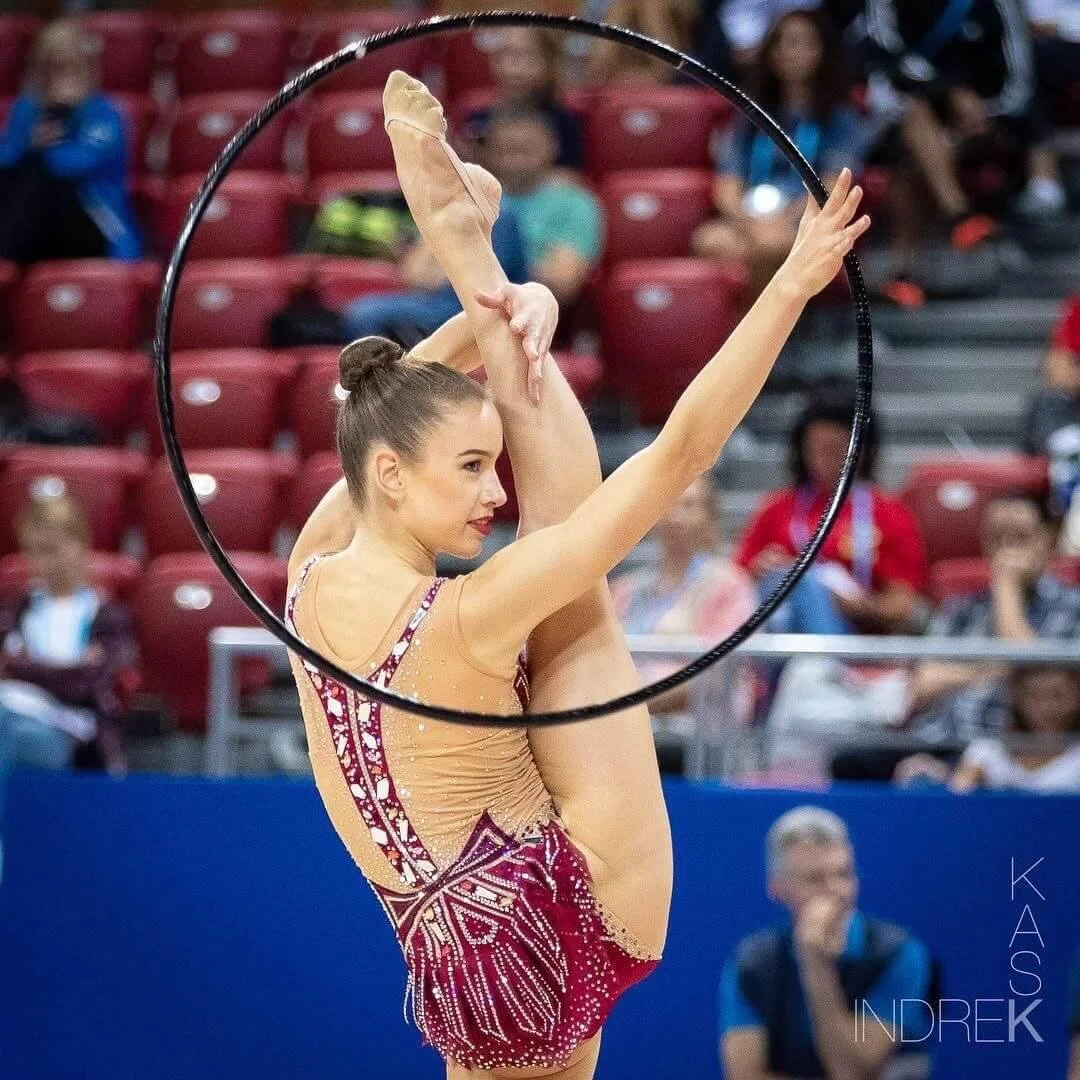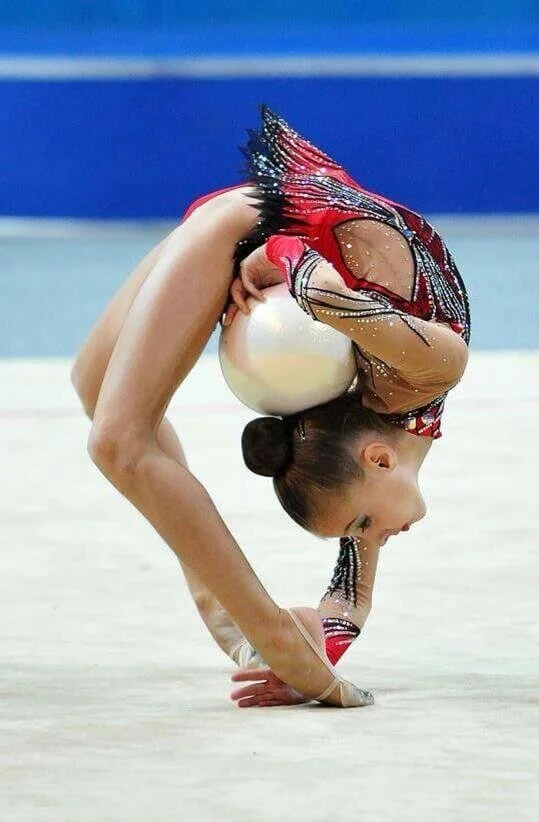A Beginner's Guide to Rhythmic Gymnastics
Your Guide to Rhythmic Gymnastics – The Sport Blurring the Lines Between Sport and Art
Rhythmic gymnastics is mostly performed by women, combining coordination, artistry and elegance.
This year marks 63 years since rhythmic gymnastics was first recognised by the International Gymnastics Federation, making it a relatively new sport.
International rhythmic gymnast Neringa Masionyte explains all you need to know about Rhythmic Gymnastics.
The author, and Lithuanian international gymnast, Neringa Masionyte, in action
Gymnastics has its roots in Ancient Greece and Egypt, where some recorded evidence on pottery of women dancing with balls was found.
With its influences in ballet, theatre and modern dance, rhythmic gymnastics took its current form in the 20th century.
In 1984, it was even included in the Olympic Games. The first gymnast to win an Olympic gold medal was a Canadian named Lori Fung.
Read a full beginner’s guide to rhythmic gymnastics, including everything you need to know about this beautiful sport.
What is Rhythmic Gymnastics?
The gymnasts perform with various apparatus, including a rope, hoop, ball, clubs and a ribbon, with athletes coordinating motions to music.
In addition to physical skills like strength, flexibility, power and coordination, rhythmic gymnastics requires an ability to interpret and express music.
The goal is to demonstrate all the years of dedication and hard training with a finely choreographed routine in a short 90-second performance.
Rhythmic gymnastics is especially popular among young people.
Gymnasts start training at the age of 3-4 years old to acquire and perfect the physical skills required for competitive sports, with gymnasts reaching their peak in their teen years.
Where is Rhythmic Gymnastics the Most Popular?
Eastern European nations, particularly the former Soviet Union countries and Bulgaria, have long dominated in rhythmic gymnastics.
Nowadays gymnasts from Russia, Ukraine and Belarus are winning most of the trophies in World Championships, Olympics and other big events.
From 2000 to 2016, all individual winners in the Olympic Games were representing Russia.
Linoy Ashram was the first gymnast in the 21st century to beat Russia, at the Tokyo 2020 Olympic Games.
The head coach of the Olympic centre, Irina Viner, plays a big role in Russia’s dominance in the rhythmic gymnastics world. She sets the bar very high, creating an intense rivalry against other countries.
Rhythmic gymnastics is also a growing sport in the UK.
Who is the greatest rhythmic gymnast of all-time?
The only individual gymnast to win the Olympics (2008 and 2012) twice is the Russian athlete Evgenia Kanaeva.
An achievement like this is very unique in rhythmic gymnastics, as gymnasts tend to quit the sport very early (usually in their 20s).
Also, being in peak form for two Olympic circles is remarkable.
Anastasia Bliznyuk also deserves to be mentioned as one of the greatest gymnasts. She became the Olympic champion in 2012 and 2016, and silver medallist in the 2020 Olympic Games.
Rhythmic Gymnastics Apparatus
Rope
The length of the rope, which is constructed of hemp or synthetic material, is determined by the height of the gymnast using it.
Gymnasts perform various movements with the rope such as throws, catches, swings and more.
The rope can be held in one or both hands, open or folded. While grasping the rope in both hands, the gymnasts also jump through it.
Hoop
The inner diameter of the plastic hoop should be between 80 and 90 centimetres.
The hoop must weigh at least 300 grams. The hoop offers the widest range of motions and features of any rhythmic gymnastics apparatus, resulting in some of the most creative and expressive routines.
During a routine, the hoop must be used on all surfaces and planes while being rolled, twisted, thrown, caught and circled.
Ball
The ball used in rhythmic gymnastics has a diameter of 18 to 20 centimetres and it is composed of rubber or synthetic material.
The ball must be at least 400 grams in weight.
The ball is the only piece of equipment in rhythmic gymnastics that cannot be grasped firmly and it can only be balanced on the body or rolled over.
Usually, ball exercises are graceful and lyrical, with flowing rather than quick motions.
A young woman performs a rhythmic gymnastics routine with the ball
Clubs
The length of a club is between 40 and 50 centimetres, and they can be constructed of plastic or synthetic material.
Each club is 150 grams in weight. To keep a track of two clubs is a lot of effort.
The gymnasts combine intricate body movements with mills, spins, circles, throws and several asymmetrical moves.
It takes coordination and rhythmic movement to handle a club.
Ribbon
The ribbon stick is often constructed of wood, bamboo or plastic and it is 50 to 60 centimetres in length. The ribbon is composed of starch-free satin or a similar material.
The ribbon has a minimum length of 6 metres and a maximum weight of 35 grams.
Although it is the most elegant apparatus in rhythmic gymnastics, it can be difficult for a gymnast to control.
Throughout the whole performance, an athlete must maintain motion with the ribbon, forming a variety of designs like spirals, circles and snakes.
Group routines
The programme for a group routine is slightly different. Five gymnasts will display a performance together in the group competition.
To successfully complete the routine, the gymnasts must cooperate.
Group routines are amazing and incredibly entertaining to watch since they provide you with the chance to support your favourite team.
They also astonish general sports fans with quick apparatus exchanges and exceptional gymnastic synchronisation.
What do Rhythmic Gymnastics Competitions Look Like?
Rhythmic gymnastics competitions take place on a floor area measuring 13 metres x 13 metres.
These competitions are split into two categories: individuals and groups.
Individuals perform four different routines in an all-around competition where their scores are combined and in the apparatus finals, their goal is to be the best with each apparatus.
In group competitions, each group performs two routines: one with the same 5x apparatus and the other with mixed 2 and 3 apparatus.
How are Gymnasts Assessed?
The Code of Points is used to assess gymnasts competing in rhythmic gymnastics competitions across the world.
This is a regulation manual published by the International Gymnastics Federation (FIG) that specifies the point values of specific skills in international competition.
The FIG developed a marking method in 2006 that combines two scores—the Execution Score (E) and the Difficulty Score (D)—to account for the difficulty of abilities and routines.
The difficulty score (D)
Four judges make up the D Panel. Each judge independently determines their Difficulty Score.
The middle two scores are averaged, while the top and lowest scores are eliminated.
Each element of the performance, including leaps, rotations, balances and the usage of apparatus, contributes to the D mark.
The score for the Difficulty is limitless.
The execution score (E)
This evaluates the performance's skill and execution. Six judges on the E Panel decide the Execution Score.
Errors in execution, such as falls, bent arms and legs and dropping apparatus result in deductions from the starting score of 10.
The execution score is determined by the average of the judges' individual assessments for each routine; the top and lowest scores are eliminated.
Is Rhythmic Gymnastics only for Women?
Rhythmic gymnastics is mostly a women's sport, bringing a lot of discussions to the table about whether it should be made a gender-neutral sport.
Male rhythmic gymnastics is only popular in Japan and Spain, where men are allowed to compete in women’s competitions. For the rest of the world, it is still considered a “women’s sport”.
At the moment, many people seem sceptical about including men's rhythmic gymnastics in the Olympic Games, letting men practice this sport only at a club level.
This competition ceiling prevents the popularisation of rhythmic gymnastics among men.
Why get involved in rhythmic gymnastics?
Rhythmic gymnastics is one of the best sports to develop body awareness and coordination abilities, helping athletes improve their athletic potential in other disciplines too.
Although this sport can be dangerous if you don’t follow an expert’s instructions, rhythmic gymnastics can help you maintain good posture by building muscle.
Gymnastics emphasises beauty, in addition to its physical needs.
Children get a sense of space and time, developing their creative abilities. This sport also cultivates memory and boosts self-esteem and confidence.
Read more on our fitness and training blog


